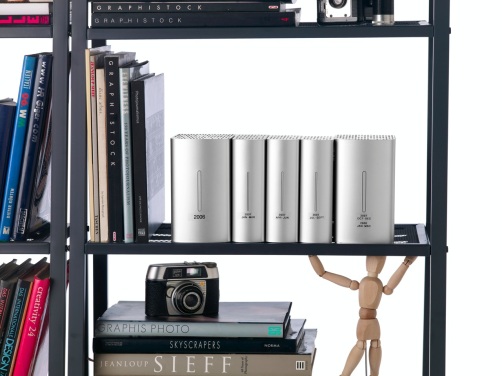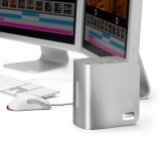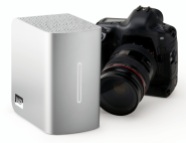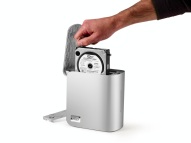
I have been working daily with a WD My Book Studio Edition II drive for the past eight months (since April ’08). I mentioned it back in July in my popular “What’s on my desk” post. It is a quad interface (USB 2.0, FW400, FW800, eSATA) 2TB drive that can run in RAID 0 (2TB total space) or RAID 1 (1TB total space). My review can be summed up in these three words: it works great.
I should say here, just as I said in my other two reviews of the My Book Pro Edition drive (see paragraph below for links), that this drive was given to me by WDC as a replacement for my faulty My Book Pro drive. I didn’t purchase it, but at the same time, I am under no obligation to anyone to praise it needlessly. I do so because it has really worked for me.
After all these months of heavy use, I have nothing bad to say about this drive. I have put it through its paces, transferring terabytes of data back and forth from it to my laptop and to my other drives, I have used it daily, I have put it through sustained data writes of several hundred gigabytes at a time, and it has not failed me yet. In stark contrast to my experience with the WD My Book Pro Edition II drive, this drive has outshined all of my other external storage devices, including my Drobo.
True, while nothing beats the Drobo when it comes to sheer storage space and flexibility in terms of its building blocks (the drives themselves), the My Book Studio Edition II drive has been faster than the Drobo when it came to working with my photos in Lightroom, in both RAID 0 and RAID 1 modes, and it has also been faster when it comes to data transfers (writing to the drive itself).

I did not have a chance to use the drive through the eSATA interface. I used it mostly through the FW800 interface, and, briefly, through the FW400 and USB interfaces. Given that it can transfer data at up to 3GB/s through eSATA, I might just buy an adaptor for my MacBook Pro in the future. I was pretty happy with the FW800 speeds though (up to 800 Mb/s).
My feelings about this drive are somewhat harder to understand for those of you that have not had to deal with a My Book Pro Edition drive. If you did not have to put up with constant overheating, data loss, fan noises, disconnects and computer resets while using that drive, then you can’t possibly appreciate how WDC managed to get things so right with the My Book Studio Edition drive.
Somehow, they have, and for me, it’s a pleasure to use this drive. It suffers from none of the problems of its predecessor. It works reliably, each and every time. It’s fast. It’s quiet. It doesn’t overheat. It doesn’t cause my computer to crash. It doesn’t lose any of my data. The enclosure looks even better. The white LED on its front is much less annoying than the blue LED on the My Book Pro. It has greater capacity. It has more interfaces. It has a 5-year warranty, which amazes me when I consider that most tech products have a 3-year projected lifespan. The list goes on and on, and I have only good things to say about it.
The drive uses the new GreenPower drives from WD, which use 30% less energy and do not get as hot as older hard drives. This means the new enclosure doesn’t need a fan. Another cool thing is that it’s much easier to replace the hard drives, since you won’t need a screwdriver. The enclosure opens easily, and the hard drives pull out with the aid of tabs. Having needed to open the enclosure for the My Book Pro Edition drive, I can tell you it was a lot more convoluted than this.

The wonderful thing about this drive is that it’s such a great deal right now. As I pointed out in a previous how to article entitled “A look at hard drives: finding the best deals“, it’s always a good idea to compare the price of the hard drives themselves to the price of the enclosure plus the hard drives, to see how much you’re paying for the packaged, branded product, and whether it’s worth it. Well, 1TB hard drives are anywhere from $100-140 at the moment (there are two of them in the My Book Studio Edition II), and the product itself costs about $280-290 right now. That means, if you factor in the best price scenario for the hard drives, that you’re getting a quad-interface enclosure which is quiet and it actually works on most computers (which isn’t something I can say about other off-the-shelf DIY enclosures) for about $80-90. That’s a great deal in my book.
Detailed specs for the My Book Studio Edition II drive are available from the WDC website. You can buy it from Amazon or from B&H Photo.
Photos used courtesy of Western Digital Corporation.










RAID 1 is rather important to me; for what if the drive enclosure fails, at least with RAID 1 one can transplant the drive into a normal enclosure and retrieve the data.
LikeLike
Well, heck you guys. I’ve spent five hours trying to get my Studio 11 up and running to no avail. It doesn’t show on my desktop nor does that included software seem to do anything at all. Nothing. I’m not very happy about this. I’m using FW800 and a 2.2gig intel core 2 duo Mac 10.6.3 and nothing what so ever seems to be working for me. I have no idea what I’m doing wrong.
LikeLike
Michael, you may need to format it first, so open up Disk Utility and see if it shows up in there. And switch to USB to see if that makes a difference.
LikeLike
Pingback: What’s on your Drobo? « Raoul Pop
How does the WD Studio Edition II compare with 2T WD My studio released in 2009 with a single 2T drive?
LikeLike
The Studio Edition II is a RAID-enabled device, which means it can run in RAID 0 or RAID 1. The My Studio Personal Editition, which I’m guessing is what you have, with a single 2 TB drive, has no raid. It’s a drive in an external enclosure.
LikeLike
I have a 4TB WD studio 2, i’m using it for final cut pro7 in raid1 there are 2 settings FAT32 or HFS+, what is better
or
should i use my 2tb imac HD instead
LikeLike
Willie, I compare FAT32 to HFS+ in this article, so I encourage you to read through it if you want to get the details, but the bottom line is that HFS+ is much better than FAT32, so use it on your drive. You can also use the internal drive of your iMac, but generally speaking, it’s better to work with large files, particularly when doing video editing, on an external drive.
LikeLike
Pingback: Hardware review: ioSafe Solo, the fireproof and waterproof drive – Reviews - Raoul Pop
Eric Mercer – did You set My Book Studio Edition II as JBOD? Is it possible?
LikeLike
Sounds like you did your homework on it! 🙂 Hope it works out great for you!
LikeLike
Raoul:
I was considering the Addonics until I’d stumbled on the PogoPlug.
It’s true that the Addonics is packed full of nice features for not too much money. (I love the Bit Torrent client). But the extra $45 gets you quite a lot more than you might think.
For one thing, you can only attach a single drive to the Addonics whereas the PogoPlug’s limit is well over 100. Plus I believe that the Addonics only supports FAT32 files while the pogo: HFS, NTFS, FAT and linux ext types. It also lets you mount drives over the internet to your local system as if they were locally attached to your Mac or PC. You can also share password protected files over the net while using the same drive locally at Gigabit speeds.
The PogoPlug is actually a dressed up linux computer with a 1.2 GHz processor, 1 GB memory, Gigabit ethernet (I believe the Addonics is only 100baseT, which is a serious fail for a networked drive).
The PogoPlug is based on a ShevaPlug plug computer by Marvel, the first in the plug computer trend. PogoPlug will soon be getting its very own API’s, so I’m sure it’s going to be an interesting ride once the SIG’s and hackers get their hands on it.
But alas, talk is cheap. I’ll let you know what promises it actually delivers on once I’ve used it firsthand…
In a ridiculous attempt to sort of get back on topic: I was hoping to connect the Studio II to it, but the pogo doesn’t support HFS journalling yet –They’re working on it… Meanwhile I’ll attach something else to it. The Drobo’s been tested and works fine with it too, btw.
LikeLike
Hi Eric. JBOD is an interesting option. For one thing, I’ve never seen it show up in my version of the WD My Book software. Perhaps it’s a later addition. For another, you won’t get the RAID 1 benefits, which is the way I run mine. If one of the drives fails, the data will be gone. I’d rather be safe than sorry…
I reviewed a product like the PogoPlug recently, in an edition of Gadget Monday. It’s called the Addonics NAS Adapter. Scroll down to it in the article. The Addonics gadget doesn’t tout iPhone access, but it does have a built-in FTP server, SAMBA support, and can be used as a print server or Bit Torrent client. And it’s $55, not $99.
Not sure about the dissimilarly sized drives. Remember, the Studio enclosure has a RAID card inside, and RAID cards want to see identical drives. But feel free to experiment once you get it, and do let me know if it does all you wanted it to do.
LikeLike
Well. I just ordered the 2TB Studio II @ $249 delivered from PC Connections. I’ll see it in about 3 weeks since I live in Lisieux France and have to wait for things to arrive via friends/family from the US… I also ordered that NewTech docking station and a PogoPlug which could use a Raoul Pop review…
I read an interesting review where Macworld says that in addition to RAID 0 & 1, the Studio II can function in JBOD mode:
http://www.macworld.com/article/133649/2008/06/mybook_studio2.html
“You can also format the drive so that the two physical drives just show up as two drives on your Mac desktop, an arrangement known as JBOD (just a bunch of disks). This format doesn’t give you either the speed benefit of a striped array or the protection of a mirrored copy of all of your data. However, it does mean that you can use all of the capacity of both drives, and if one drive fails, you only lose the data on that drive.”
I’m glad it apparently has that additional option. If that’s true, the Studio II ought to accept dissimilarly sized drives since that’s what JBOD is all about. In this case, more like JTOD (just two, **only**, disks)…
LikeLike
Hi Eric. I’m confirming Greg’s comment above. He’s right, you can only use it as a single external disk, not as a two-disk docking station. If you want that functionality, you’re better off getting that docking station from MacSales. (I bought stuff from MacSales repeatedly and I like them.)
The reviews of the DroboPro and the Qnap might have to wait a while. I’m staying in Romania for the time being, and it’s a serious hassle to ship stuff here from the US. The customs fees are horribly high — basically, the cost of entry into the EU — so I don’t think either Data Robotics or Qnap would be inclined to ship stuff here and cover the customs fees, unless they know of a way to get around them.
Keep in mind the Qnap is a RAID array, and you will need to use identical drives in it (all 6 of them). The DroboPro will let you use drives of different sizes, so you may want to take that into consideration. As for Synology, I haven’t used them, only heard about them from you, but they’re also RAID, so again, you’d run into the requirement for using identical drives.
Greg, if you replaced a drive in the unit, provided you did it with the power off, like the manual says, then it would probably format it on start-up and sync the data automatically. That’s just my guess though. I haven’t run through the process yet, and I hope I won’t have to any time soon, because it would mean a drive failure, and I’d rather not have a drive failure right now…
LikeLike
The nature of the Western Digital enclosures make the two drives indistinguishable to the OS, and the computer will recognize it as 1 physical disk. If you choose for the disk to be mirrored (RAID 1) or stripped (RAID 0) – not recommended in my opinion. Since the Western Digital Drive manager handles the hard disk raid setup it wouldn’t be possible to use this device as anything but an external harddrive. Even if you used an external hard disk docking station, when you inserted those drives into the Western Digital, they would probably have to be reformatted to meet the WD drive manger striping or mirroring raid scheme. I think these drives are affordable, but I don’t think they are as robust as a g technology solution that allows for hotswapable drives. I’m actually curious what the process would be for replacing one of the drives in a mirrored setup. Would it automatically sync the data from the existing good drive to the new ‘blank disk’ of same size, spec, etc.
LikeLike
Raoul:
Thanks for your quick comments.
Does the Studio II allow the 2 disks to also mount as 2 independent volumes rather than just striped vs mirrored?
If so, I wonder if this enclosure could alternatively be used as a **two-disk** quad-interface docking station allowing esata II speed disk-to-disk xfrs between two temporarily inserted 3.5″ drives.
(http://eshop.macsales.com/item/Newer%20Technology/FWU2ESHDK/)
The Studio II is going for about $240 right now and I’m about to pull the trigger thanks to your review. Great bargain if they’re all as reliable as the one you reviewed given the My Book Series’ dubious reputation. There’s something about them that makes us want to keep taking the risk.
Can’t wait for your hands-on review of the Drobo Pro. Any chance of a review for the Qnap 639 vs the Dobro Pro as well? I’m thinking I’d eventually like to use one or the other. The Pro looks great w/ 8 vs 6 drives and 2tb drive limit vs 1.5 for the Qnap. But the Qnap is reputed to function well in real-life vs specs. They also seem more robust than Synology products. Meanwhile, getting a Studio II should hold me over till the jury is in on these two new models.
BTW: et al = all who read & comment on your reviews. Your generous work is much appreciated!…
LikeLike
I got a warranty replaced MyStudio drive from WD, and the top won’t stay closed. But it did say that WD ‘green’ hardisks must be used most likely to keep the heat down. As Raoul wrote, you would need to use two drive of the same size in order for the western digital drive manager software or entire device to work properly.
LikeLike
Raoul et al:
Great reviews. Especially on the drobo series. Concerning the Studio II:
Does anyone know what the capacity limit is when replacing the drives? Can one replace the two 1TB drives with two 2TB drives (or larger), for example?:
One scenario would be that you’re using it in Raid 1 mode (mirroring) and one of the two drives fail. Could you replace it with a 2TB drive? Then, once you eventually run out of disk space on the original 1TB or it fails, you then replace it with say a 3TB drive and so on and so forth…
Brief:
1) What is the drive capacity limit
2) Will it operate in Raid 1 with two dissimilar sized drives
I can’t find the answer to these question anywhere on the net. Even WD doesn’t specify capacity limits for the drive. Thanks all!
LikeLike
Eric, I don’t think there’s a capacity limit. I think you can safely assume that you can replace the 1TB drives with 2TB drives. After all, that’s why WD made the enclosure easier to open and service than previous builds. You cannot, however, assume that you can operate in RAID 1 with different drive sizes. RAID, by its very nature, requires that you use two identical drives (same exact specs per drive). The only scenario where you can use different drives and get the benefits of RAID, is, to my knowledge, with the Drobo. Hope this helps, and btw, there is no et al, just me.
LikeLike
Zed,
Check out Digital-heaven.
http://www.digital-heaven.co.uk/freeware
Disksomnia is the freeware app that you will want to keep those disks spinning. Great review Raoul!
LikeLike
Has anyone used one of these in Raid 1 with Final Cut Pro??
I hear there’s an energy – saving function that can’t be turned off. This would be wouldn’t be good news for my render files if it is the case.
LikeLike
Hey! I had to buy this piece of hardware after reading your review, and I must say… i’m not regretting it one bit!
10x 🙂
LikeLike
Glad to hear it, Chris!
LikeLike
Hey! In the meantime, I downloaded the new firmware for the drive as well as the new drivers and it works like charm. Thanks anyways!
LikeLike
Good to hear that!
LikeLike
Hi! Did you manage to work with this HD and Firewire without any problems? I just bought it, connected it via FW and – in contrary to a connection through USB – the HD is not recognized by my less than a year old iMac. It does not even appear in the harddisc-utility. Do you have any ideas?
LikeLike
Michael, I had no problems whatsoever with the drive. What FW connection did you try? FW400 or FW800? Did you make sure to eject it properly from your iMac and disconnect the USB wire before connecting it via FW?
LikeLike
Pingback: What’s on my desk? by Raoul Pop